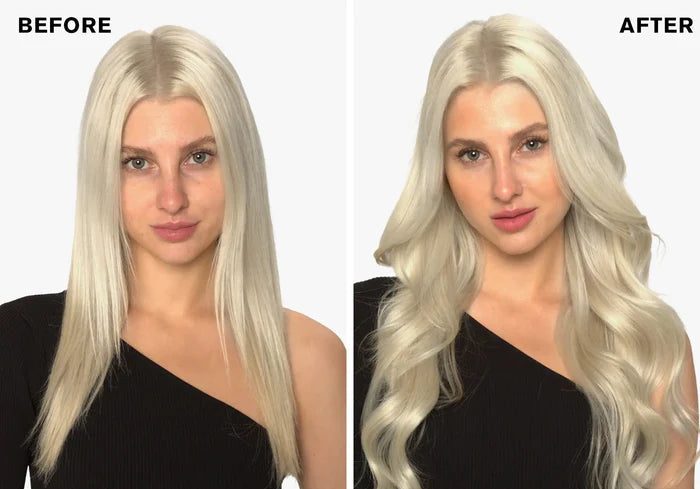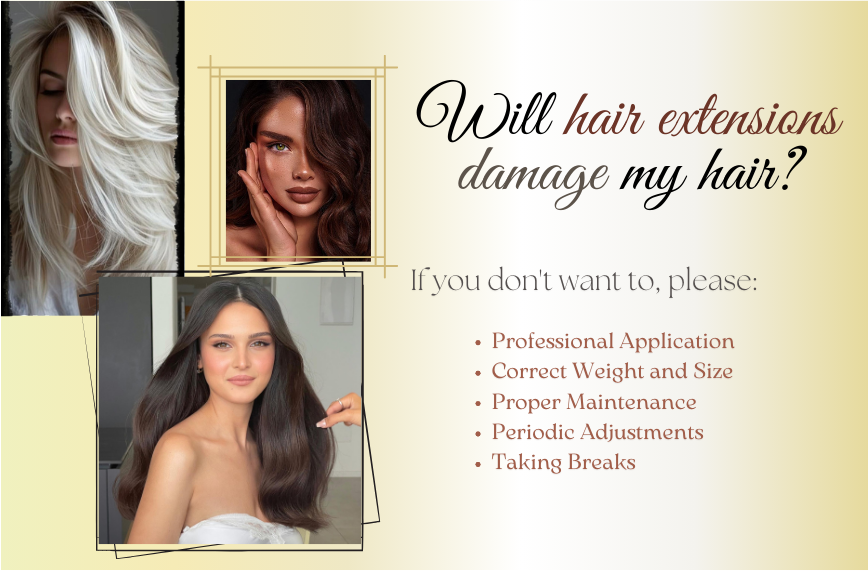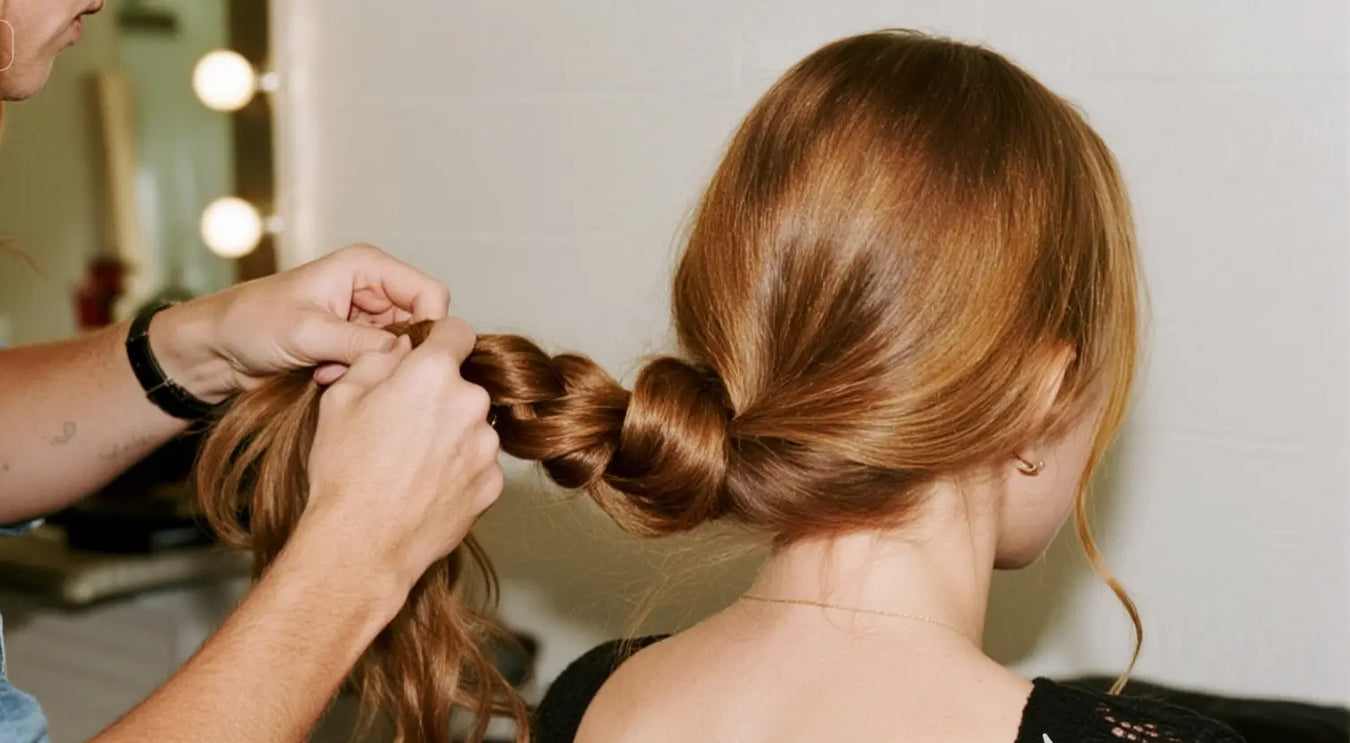
Best Sellers
Discover our top-selling hair extensions loved by thousands! Find the perfect length, color, and style that’s flying off the shelves.

Hair extensions do not necessarily damage your natural hair if they are applied and maintained correctly. Professional application ensures that the extensions are evenly distributed and attached without excessive tension on your scalp or hair follicles. Furthermore, choosing high-quality extensions and following a proper maintenance routine, such as regular washing, gentle styling, and avoiding pulling or tugging, can prevent stress on your natural hair. It's also essential to give your hair periodic breaks from extensions to allow it to recover and maintain its health.
This blog will tell you how to properly apply hair extensions in order to prevent them from damaging your original hair.
Extensions applied by a professional stylist ensure that the method used is suitable for your hair type and properly executed to avoid strain on your roots and scalp.
Always have your extensions installed by a professional stylist experienced in the type you want. An expert will not only choose the best method suited to your hair type but also ensure that the extensions are applied correctly, reducing the risk of hair breakage or scalp irritation.
Several types of hair extension installations require the expertise of a professional hairstylist due to their complexity and specialized techniques. These include:
①Fusion Extensions: Fusion extensions involve bonding small strands of hair extensions to sections of natural hair using a keratin-based adhesive. This technique requires precision and skill to ensure a seamless and natural-looking blend between the extensions and the natural hair.
②Micro-Bead Extensions: Micro-link extensions involve attaching small sections of hair extensions to natural hair using tiny metal beads or rings. The stylist must carefully thread the natural hair through the bead and secure it in place without causing damage to the hair or scalp.
③Sew-In Extensions: Sew-in extensions involve braiding sections of natural hair and then sewing the extensions onto the braids using a needle and thread. This technique requires expertise in braiding and sewing to ensure a secure attachment without causing tension or discomfort to the scalp.
④Bonding Extensions: Bonding extensions involve applying wefts of hair extensions to natural hair using a special adhesive. This technique requires skill to ensure proper placement and bonding of the extensions while minimizing the risk of damage to the natural hair.
⑤Custom Wig or Hairpiece Creation: Creating custom wigs or hairpieces involves designing and constructing a hairpiece tailored to the client's specifications and needs. This requires expertise in hair styling, cutting, and shaping to achieve the desired look and fit.
Professional hairstylists are trained to perform these techniques safely and effectively, ensuring that the extensions are applied securely and blend seamlessly with the natural hair. They also have the knowledge and experience to address any potential issues or concerns during the installation process, providing clients with a high-quality and satisfactory result.
Using extensions that match the thickness and weight of your natural hair prevents excessive tension that could lead to breakage or hair loss.
Selecting the right type of extensions is crucial. Consider lighter options like tape-in or clip-in extensions that put less strain on your hair follicles compared to heavier types like fusion or micro-links. Your choice should align with your hair type and lifestyle for the best results and minimal damage.
Selecting the right size, weight, and color of hair extensions is essential for achieving a natural and flattering look. Here's how to do it:
①Size: Measure the length of your natural hair and determine where you want the extensions to fall. Choose extensions that closely match this length to ensure a seamless blend. If you're looking to add volume rather than length, opt for extensions slightly shorter than your natural hair.
②Weight: Consider the thickness and density of your natural hair when selecting the weight of the extensions. For thin or fine hair, lighter-weight extensions are recommended to prevent strain on the hair follicles. Those with thicker hair can opt for heavier extensions for added volume and fullness.
③Color: Match the color of the extensions to your natural hair as closely as possible for a seamless blend. Take into account factors such as undertones, highlights, and lowlights when selecting the shade. If your natural hair color is multidimensional, consider using a blend of extension shades or opting for ombre or balayage extensions for a more natural look. If you really don’t know how to match hair color, please feel free to consult us via email: service@g-sunny.com
④Texture: Choose extensions with a texture that closely matches your natural hair, whether it's straight, wavy, or curly. This will help the extensions blend seamlessly with your hair and minimize the need for styling.
⑤Quality: Invest in high-quality extensions made from human hair for the most natural look and feel. Human hair extensions can be styled, colored, and treated just like your natural hair, providing greater versatility and longevity.
⑥Consultation: If you're unsure about which extensions to choose, schedule a consultation with a professional hairstylist. They can assess your hair type, color, and texture and recommend the most suitable extensions for your needs.
By carefully considering factors such as size, weight, color, and texture, you can select the perfect hair extensions to enhance your natural beauty and achieve the desired hairstyle.
Maintaining the health of your hair after getting extensions is crucial to ensure their longevity and the well-being of your natural hair. Here's how to do it:
①Regular Washing: Wash your hair and extensions with a sulfate-free shampoo and conditioner to keep them clean and free of buildup. Be gentle when washing to avoid tangling or pulling on the extensions.
②Moisturizing: Use leave-in conditioners or hair oils to keep both your natural hair and extensions moisturized and hydrated, especially the ends which tend to be drier. Avoid applying products directly to the bonds or attachment points to prevent loosening.
③Avoiding Heat Damage: Minimize heat styling and use heat protectant sprays when using hot tools to style your hair. Excessive heat can damage both your natural hair and the extensions, leading to dryness and breakage.
④Detangling with Care: Use a wide-tooth comb or a special extension brush to gently detangle your hair, starting from the ends and working your way up. Avoid pulling or tugging on the extensions to prevent damage.
⑤Protective Hairstyles: Opt for protective hairstyles such as braids or buns to minimize manipulation and friction on the extensions. This also helps to prevent tangling and maintain the integrity of the bonds or attachment points.
⑥Regular Maintenance: Schedule regular maintenance appointments with your stylist to check on the condition of your extensions and address any issues such as loose bonds or tangled strands. Trim the ends of your natural hair as needed to prevent split ends.
⑦Avoiding Chemical Treatments: Refrain from coloring, perming, or chemically treating your hair while wearing extensions, as these processes can weaken both your natural hair and the bonds holding the extensions in place.
⑧Protecting Extensions at Night: Tie your hair up in a loose braid or ponytail before sleeping to prevent tangling and friction while you toss and turn. Consider using a silk or satin pillowcase to reduce friction and minimize damage.
⑨Balanced Diet and Hydration: Maintain a healthy diet rich in vitamins and minerals, and stay hydrated to promote the overall health of your hair and scalp, which in turn benefits the extensions.
By following these guidelines and incorporating good hair care practices into your routine, you can keep your hair extensions looking beautiful and your natural hair healthy.
Regular visits to a stylist to adjust the extensions as your natural hair grows can prevent pulling and stress on your roots. Hair extensions require periodic adjustments for several important reasons:
①Natural Hair Growth: As your natural hair grows, the distance between the scalp and the point of attachment of the extensions increases. This growth can cause the extensions to weigh down on the natural hair, leading to potential strain or damage. Adjusting the extensions helps reposition them closer to the scalp, ensuring they are supported and less likely to cause tension.
②Avoiding Matting and Tangling: Over time, hair extensions can become tangled with natural hair. This is especially true for methods like fusion, tape-ins, and weaves. Regular maintenance helps detangle and properly align the extensions with natural hair, preventing matting and reducing the risk of knots that can lead to hair breakage.
③Maintaining Appearance: Adjustments are crucial to maintain the aesthetic quality of hair extensions. As natural hair and extensions can differ in texture and growth patterns, periodic adjustments ensure that the extensions blend seamlessly with your natural hair, maintaining a natural and appealing look.
④Preventing Scalp Stress: If extensions are left without proper maintenance for too long, they can pull on the natural hair and scalp, causing discomfort and even leading to hair loss in some cases. Regular adjustments relieve any undue stress on the scalp and help distribute the weight of the extensions more evenly.
⑤Extension Longevity: Proper maintenance, including adjustments, extends the life of the hair extensions. By regularly addressing issues like loose bonds or tapes, the overall structure and integrity of the extensions are preserved, allowing them to last longer.
⑥Hygiene: Adjustments often coincide with the removal of the extensions for thorough cleaning, which is essential for maintaining scalp health. This prevents buildup of products and oils that can lead to scalp irritation or infections.
Thus, regular adjustments are essential not only for maintaining the health of your natural hair and scalp but also for ensuring the longevity and aesthetic quality of the extensions.
Periodically removing extensions allows your scalp and hair time to rest and recover from any stress caused by the added weight of the extensions.
Frequent heat styling and harsh chemical treatments can damage both your extensions and your natural hair. Try to keep styling to a minimum and use heat protectant sprays when using tools like straighteners or curling irons. Opt for natural drying when possible and use gentle, low-heat settings for drying and styling.
Taking breaks from hair extensions is important to give your natural hair and scalp a chance to rest and recover from the stress of wearing extensions. Here's why it's necessary and some recommendations:
①Scalp Health: Constant tension from the weight of extensions or tight attachment methods can lead to scalp irritation, inflammation, and even hair loss over time. Taking breaks allows the scalp to breathe and reduces the risk of these issues.
②Prevention of Damage: Continuous wear of extensions can cause damage to your natural hair, including breakage, thinning, and traction alopecia. Giving your hair periodic breaks helps prevent these problems and promotes overall hair health.
③Regrowth: Allowing your natural hair to grow without extensions gives it the opportunity to rejuvenate and regrow any damaged or weakened strands. This can result in healthier, stronger hair in the long run.
④Maintenance: Breaks provide an opportunity to properly maintain and care for your natural hair, including washing, conditioning, and deep conditioning treatments. This helps keep your hair in optimal condition for future extension applications.
⑤Variety: Taking breaks allows you to experiment with different hairstyles and give your hair a chance to shine on its own. Embrace your natural hair texture and length during these periods, and explore different styling options.
Recommendations for taking breaks from hair extensions:
①Schedule Regular Breaks: Plan periodic breaks from wearing extensions, such as a few weeks every few months, to give your hair and scalp time to rest and recover.
②Proper Removal: Ensure that extensions are removed carefully and gently to minimize stress on the hair and scalp. Seek professional assistance if needed.
③Scalp Care: During breaks, focus on scalp care by using soothing and nourishing treatments to promote a healthy scalp environment.
④Protective Styling: Consider wearing protective hairstyles during breaks to minimize manipulation and protect your natural hair from environmental damage.
⑤Monitor Hair Health: Pay attention to the condition of your natural hair during breaks and address any issues promptly to maintain its health and vitality.
By incorporating regular breaks into your hair extension routine and following these recommendations, you can promote the overall health and well-being of your natural hair while still enjoying the versatility and beauty of extensions.
When these practices are followed, hair extensions can be a safe way to enhance the length, volume, and appearance of your hair without causing damage. You can enjoy the aesthetic benefits of hair extensions without compromising the health and integrity of your natural hair. Remember, the key to successful hair extensions lies in proper application, maintenance, and regular care.

Discover our top-selling hair extensions loved by thousands! Find the perfect length, color, and style that’s flying off the shelves.

Use this section to welcome customers to your store, say a bit about your brand, or share news.

Love hair styling and beauty tips? Join our community as a contributor and share your expertise with our audience.

Earn rewards by sharing our products! Join our Affiliate Program and get commissions for every sale made through your referral link.